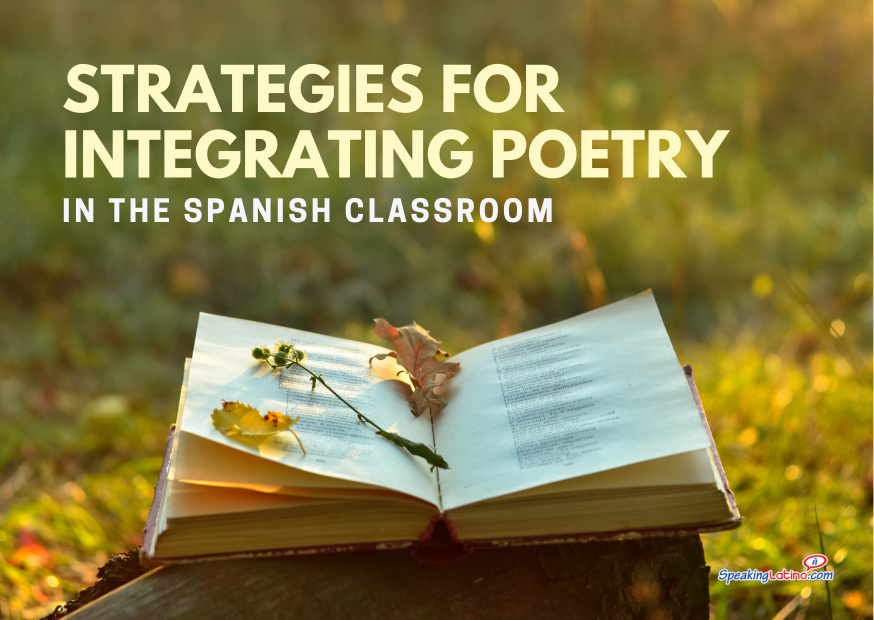
The content of this article is based on the presentation, Using Comprehensible Poetry in the Spanish Classroom by Diego Ojeda, which was part of the World Language Teacher Summit.
The Transformative Power of Poetry in Language Learning
The integration of poetry in the language classroom is not merely an academic exercise; it is a profound avenue through which students can connect with the history, nuances, and soul of a language.
In the context of the Spanish classroom, comprehensible poetry emerges as a significant pedagogical tool that situates language within the reach of learners, aligning it with the vitality of Hispanic culture.
The Essence of Comprehensible Poetry
Enabling Connection Through Language Comprehension
Comprehensible poetry strips away the barriers that often render classical literary texts intimidating for language learners. By offering poetry written with familiar vocabulary and structures, educators help students navigate new linguistic landscapes with confidence. This brand of poetry relies on everyday language, mirroring the conversations and interactions that students aim to partake in with native speakers. As students work through poems that they can comprehend, their active participation in the classroom is amplified, fostering a more dynamic language acquisition process.
Bridging Culture and Spanish with Poetry
Language is a reflection of culture, and the study of poetry in the Spanish classroom provides boundless opportunities for cultural exploration. Poetry serves as a lens through which the experiences of Hispanic peoples can be viewed, understood, and empathized with. Using culturally authentic and significant texts, educators not only maintain the interest and curiosity of students but also instill a deep-rooted respect for the cultural contexts that shape the language they are learning.
Dynamic Approaches to Poetry Education
Strategies Promoting Student Comprehension and Involvement
For poetry to resonate with students, educators must equip them with the means to decipher and internalize poetic messages. Visual aids such as illustrations offer clarity. Reciting poetry connects the oral skills of language with expressive fluency. Introducing vocabulary by highlighting its relevance to the poem and the learner's life enhances retention and personalizes the learning experience.
Employing thinking maps can scaffold vocabulary development and comprehension. Further, rewriting poetry, dramatizing poem narratives, and embracing multiple interpretations stimulate critical engagement and broaden students' analytical capabilities. Such activities encourage a more profound inquiry into both the language and the content presented, leading to a deeper learning experience.
Aligning Poems with Student's Linguistic Abilities (Content)
Selecting poetic texts that reflect the students' linguistic abilities and personal interests is crucial for ensuring their full participation. To promote sustained interest and prevent feelings of overwhelm, short, comprehensible poems are particularly useful for beginners. Diverse poetic forms, from the haiku to the sonnet, cater to different learning preferences, allowing for a tailored approach that can suit the unique tastes and proclivities of each student.
Expanding Linguistic Horizons with Poetic Texts (Language Proficiency)
Poetry serves as a conduit to refine language skills, offering a space to encounter and practice vocabulary and grammatical structures within a culturally rich context. Moreover, the rhythmic and stylistic elements of poetry exemplify advanced language features, such as idioms and metaphors, providing an authentic context for higher-order language learning.
By integrating poems into the instruction, language learners can gain familiarity with language patterns and the expressive potential of Spanish, thereby developing a more nuanced and sophisticated understanding of the language that extends beyond the practical.
Interactive Learning with Poetic Materials
Transforming a poetry lesson into an interactive session can be achieved through various inventive teaching methods. Activities that require students to recreate poems or act out scenes from them encourage linguistic experimentation and creativity. Accepting that a poem can encapsulate diverse meanings not only recognizes poetic ambiguity but also fosters a classroom environment where interpretive freedom and personal insight are valued. These approaches position learners as active creators of meaning, fundamentally altering their relationship with the language being studied.

Poetry serves as a lens through which the experiences of Hispanic peoples can be viewed, understood, and empathized with.
Evaluating the Impact and Overcoming Potential Obstacles
Implementing comprehensible poetry in the Spanish classroom carries a plethora of advantages, such as heightened student engagement and cultural comprehension. Notwithstanding, challenges akin to those faced in English literature classes can emerge due to variable experiences with and attitudes towards poetry.
Nonetheless, through preliminary exercises tailored to introduce and familiarize students with poetry, educators can anticipate and tackle these hurdles, ensuring a smoother transition into poetic studies.
FAQs About Comprehensible Poetry
How can teachers incorporate comprehensible poetry effectively in the Spanish classroom?
Teachers can incorporate comprehensible poetry effectively in the Spanish classroom by selecting texts that align with students' language proficiency levels. It is essential to choose poems that contain vocabulary and structures within the students' grasp, ensuring that the text is comprehensible yet slightly challenging to promote language growth.
Additionally, teachers should focus on selecting topics that resonate with students' interests, age, and experiences to enhance engagement and relevance.
By avoiding overly complex language and incorporating familiar themes, teachers can create a meaningful and engaging learning experience for students.
Furthermore, integrating dynamic activities that go beyond simple question-and-answer formats can help students interact with the poetry on a deeper level. By encouraging students to explore cultural backgrounds through poetry, teachers can foster a deeper connection to the Hispanic world and promote cultural understanding .
Ultimately, by making poetry accessible, engaging, and culturally relevant, teachers can effectively incorporate comprehensible poetry in the Spanish classroom to enhance language learning and appreciation for Hispanic culture.
How does poetry assist in establishing a deeper connection with Hispanic culture and language for students?
Poetry plays a crucial role in helping students establish a deeper connection with Hispanic culture and language by providing a window into the soul of the language and its people.
Through poetry, students can explore subjective expressions of emotions, experiences, and perspectives that are unique to the Hispanic culture . Unlike traditional texts, poetry allows for a more nuanced and multifaceted exploration of themes, enabling students to delve into universal topics while also gaining insights into personal relationships and feelings .
This multifaceted approach to poetry enables students to engage with various aspects of Hispanic culture simultaneously, fostering a deeper understanding and appreciation for the richness and diversity of the language and its people .
Furthermore, poetry serves as a bridge between language and culture, offering students a glimpse into the lived experiences and worldviews of Hispanic individuals . By immersing themselves in the poetic expressions of the language, students can develop a more profound connection to the cultural nuances and linguistic subtleties embedded in the verses.
Through poetry, students can not only enhance their language skills but also gain a deeper insight into the values, beliefs, and traditions that shape the Hispanic world .
Overall, poetry acts as a powerful tool for students to connect with Hispanic culture on a personal and emotional level, fostering a deeper appreciation and understanding of the language and its cultural context.

Reciting poetry connects the oral skills of language with expressive fluency.
What examples of comprehensible poetry can be utilized with students at different proficiency levels?
Examples of comprehensible poetry that can be utilized with students at different proficiency levels include:
Beginner Level:
- Simple poems with clear language and straightforward themes.
- Poems with repetitive structures or refrains for easy comprehension.
- Poems that focus on basic vocabulary and common language structures.
Intermediate Level:
- Poems with slightly more complex vocabulary and sentence structures.
- Poems that introduce figurative language such as similes and metaphors.
- Poems that explore deeper themes while still maintaining clarity and accessibility.
Advanced Level:
- Poems with rich imagery and nuanced language.
- Poems that challenge students with abstract concepts and multiple interpretations.
- Poems that incorporate cultural references and historical contexts for deeper analysis.
By selecting poems that align with students' proficiency levels, teachers can effectively engage learners at various stages of language acquisition and provide opportunities for growth and exploration in the Spanish language .
The Impact of Comprehensible Poetry in Language Teaching
Adopting comprehensible poetry in Spanish language teaching is a strategy of valuable consequence. It embodies the quintessence of language—a meaningful art form that allows for the exploration of culture, emotion, and human connection.
Comprehensible poetry invites learners to actively immerse themselves in the language, going beyond grammar and vocabulary to truly experiencing its cultural essence. It empowers educators to facilitate a learning environment that is not just about Spanish language acquisition but also about fostering an enduring appreciation for the beauty and depth of poetic expression.
Through comprehensible poetry, language education transcends the ordinary, offering students a rich, illuminating, and infinitely rewarding journey into the world of Hispanic language and literature.
Discover more language teaching techniques to help you in your classroom.